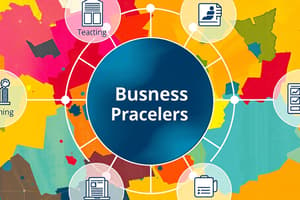Podcast
Questions and Answers
What is a significant benefit of implementing an ERP system?
What is a significant benefit of implementing an ERP system?
- Guarantee of profit increase within the first year
- Complete elimination of all operational challenges
- Improvement in organization-wide efficiency (correct)
- Reduction of employee workload immediately
Which management level primarily focuses on strategic planning within an organization?
Which management level primarily focuses on strategic planning within an organization?
- Mid-Management
- Functional Management
- Strategic Management (correct)
- Operational Management
What is one of the main challenges faced during ERP implementation?
What is one of the main challenges faced during ERP implementation?
- Increased employee satisfaction
- Overly simplified workflows
- Integration of legacy systems (correct)
- High consistency in user training
Why do organizations need integrated information systems?
Why do organizations need integrated information systems?
What does the ERP life cycle primarily outline?
What does the ERP life cycle primarily outline?
What is a common misconception about ERP systems compared to conventional software?
What is a common misconception about ERP systems compared to conventional software?
Which aspect is crucial for successful ERP implementation?
Which aspect is crucial for successful ERP implementation?
What is a primary role of information systems in business organizations?
What is a primary role of information systems in business organizations?
What is the primary role of an ERP system in an organization?
What is the primary role of an ERP system in an organization?
Which type of architecture focuses specifically on the physical components of an ERP system?
Which type of architecture focuses specifically on the physical components of an ERP system?
What is an essential factor for successful ERP implementation?
What is an essential factor for successful ERP implementation?
What benefit does a well-designed architecture provide for ERP systems?
What benefit does a well-designed architecture provide for ERP systems?
Which of the following ERP vendors is NOT mentioned as providing modules for business functions?
Which of the following ERP vendors is NOT mentioned as providing modules for business functions?
What architecture type is mentioned as having an impact on ERP systems alongside others?
What architecture type is mentioned as having an impact on ERP systems alongside others?
What should management do to enhance the understanding of ERP systems within the organization?
What should management do to enhance the understanding of ERP systems within the organization?
Business process architecture is considered essential for which aspect of ERP implementation?
Business process architecture is considered essential for which aspect of ERP implementation?
What is a primary purpose of developing information systems for organizations?
What is a primary purpose of developing information systems for organizations?
Which step involves creating a policy that supports older legacy applications?
Which step involves creating a policy that supports older legacy applications?
What is essential for integration in the short term if existing applications must be retained?
What is essential for integration in the short term if existing applications must be retained?
Why is a single sign-on policy important in an integrated system?
Why is a single sign-on policy important in an integrated system?
Which step emphasizes the importance of centralized IT support?
Which step emphasizes the importance of centralized IT support?
What is the purpose of a good back-up and recovery system?
What is the purpose of a good back-up and recovery system?
Which step should an organization prioritize to avoid support and maintenance issues?
Which step should an organization prioritize to avoid support and maintenance issues?
What aspect does business process reengineering focus on in an organization?
What aspect does business process reengineering focus on in an organization?
What is a key benefit of using a three-tier ERP architecture?
What is a key benefit of using a three-tier ERP architecture?
Which tier of a three-tier ERP architecture focuses on the structure of organizational data?
Which tier of a three-tier ERP architecture focuses on the structure of organizational data?
Which of the following is a drawback of server-centric architecture?
Which of the following is a drawback of server-centric architecture?
What is a potential limitation of implementing a multi-tiered architecture?
What is a potential limitation of implementing a multi-tiered architecture?
How does web-based architecture enhance ERP functionality?
How does web-based architecture enhance ERP functionality?
What is an advantage of flexible partitioning in a multi-tier ERP system?
What is an advantage of flexible partitioning in a multi-tier ERP system?
Which of the following is a benefit of server-centric architecture compared to client-centric architecture?
Which of the following is a benefit of server-centric architecture compared to client-centric architecture?
Which tier allows users to access and analyze information through a web browser?
Which tier allows users to access and analyze information through a web browser?
What is a key benefit of cloud computing mentioned?
What is a key benefit of cloud computing mentioned?
What is a significant drawback of using cloud computing?
What is a significant drawback of using cloud computing?
Why is enterprise architecture crucial for organizations?
Why is enterprise architecture crucial for organizations?
Which type of architecture separates the application from the presentation layer?
Which type of architecture separates the application from the presentation layer?
What must management do regarding new technologies?
What must management do regarding new technologies?
What is a characteristic of service-oriented architecture?
What is a characteristic of service-oriented architecture?
What type of architecture is the simplest form mentioned?
What type of architecture is the simplest form mentioned?
Which aspect is NOT included in system architecture considerations?
Which aspect is NOT included in system architecture considerations?
Flashcards are hidden until you start studying
Study Notes
Information Systems Evolution
- Businesses require complex information systems to manage their operations.
- Information systems provide support for various business functions including accounting, finance, HR, marketing, and operations.
- Information systems are categorized by their management levels: strategic, mid-management, and operational.
Information Silos and Systems Integration
- Over time, different information systems can create independent silos, leading to bottlenecks and inefficiencies.
- Organizations need to be agile and flexible, requiring integrated data, applications, and resources across the organization.
Systems Integration
- Logical integration involves developing systems that share data based on authorization and need.
- Physical integration focuses on seamless connectivity between different systems.
- Business process reengineering involves changing employee mindset to adapt to new ways of working.
Steps in Integrating Systems
- Resource Categorization: IT support for an integrated environment is crucial to avoid maintenance and support issues.
- Compliance & Standards: Implementing a single sign-on policy allows employees access to an integrated system from anywhere, anytime.
- Legacy Systems Support: Develop a policy for managing older legacy applications.
- Middleware Tools: Tools necessary for short-term integration, especially when existing applications must be utilized.
- Authentication & Authorization Policies: Single sign-on policies govern access to applications and data.
- Centralized IT Services & Support: A centralized IT help desk supports all applications and platforms.
- Back-up, Recovery & Security: Essential to secure data against system failure or disasters.
Enterprise Systems Architecture - Why Study?
- Helps management and implementation teams understand the features and components of enterprise systems.
- Creates a visual representation of complex system interfaces (ERP applications, databases, operating systems, legacy applications, and networking).
- Enables better IT planning by clarifying requirements for infrastructure, training, change management, and business process reengineering.
Components of an Enterprise Systems Architecture
- Functional: Defines ERP modules that support various business functions
- Examples: accounting, human resources, procurement, fulfillment
- System: Defines the ERP architecture through the physical components of hardware, software, and networking.
ERP Modules
- Provide support for major business functions like accounting, sales, inventory control, and production.
- Vendors such as SAP, Oracle, and Microsoft offer modules for different functional areas.
- ERP software embeds best practices, implementing organizational policies and procedures through business rules.
Benefits of ERP Modules
- Scalability: Easy to add, change, and remove applications.
- Reliability: Multiple levels of redundancy.
- Flexibility: Easy to partition.
- Maintainability: Lower support and maintenance costs.
- Reusability: Easy to implement reusable components.
- Security: More controlled systems for higher security.
Limitations of ERP Modules
- Can be expensive and complex.
Tiers of ERP Architecture
- Web Tier: Web-based portal for user access to information through a web browser.
- Application Tier: Web browser and reporting tools, where business processes and users interact. It shields users from the inner workings of the ERP system.
- Data Tier: Focus on organizational data structure and relationships with internal and external systems.
Web Services Architectures
- Web-based architecture (often considered a fourth tier) splits the Web Tier into Web Services and Web Browser tiers.
- Focuses on the Internet for internet-based access and integration.
- Technologies include Web Server, ERP Portal, Back-end Server Integration, Browse Plug-ins or Applets.
Benefits of Web-Based Architectures
- Many users can access ERP applications over the web.
- Easy integration of ERP applications with existing systems.
- Server-centric, no complex or expensive client software installation.
- Secure end-user access to ERP applications.
- Client-centric architectures offer faster response times.
- Allows for better system-to-system integration.
Drawbacks of Web-Based Architectures
- Client-centric architectures lack security.
- Server-centric architecture is slower.
Cloud Computing Benefits
- Dynamic scalability on demand.
- No maintenance fees for software or hardware.
- Promotes green computing environment with servers running on clean energy.
- Guaranteed reliability.
Drawbacks of Cloud Computing
- Data security concerns.
- Vulnerabilities.
- Potential conflicts of interest.
- Not suitable for highly competitive industries with sensitive intellectual property.
Implications of ERP Architecture for Management
- Enterprise architecture is crucial for long-term organizational functioning.
- ERP architecture decisions are complex and impact people, organizational policies, and business processes.
- Architecture needs to be flexible to support various hardware and software platforms.
- Management needs to filter out hyped technologies that do not provide value.
Summary of Enterprise Systems Architecture
- Answers questions about: system appearance, function, development, required infrastructure, and potential application scope.
- Includes ERP modules and ERP architecture.
- Vendors provide modules: from basic functions (accounting, finance, HR, marketing) to advanced functions (self-service, compliance management, business intelligence).
- Traditionally organized into three tiers for flexibility and scalability: Data, Application, and Presentation.
- Various layered architectures exist: Two-tier (simplest), Three-tier (separates application from presentation layer), Web-based (facilitates integration with Internet technologies), Service-oriented (separates service provider from consumer).
- Service-oriented architecture has a higher degree of separation similar to object-oriented system architecture.
Studying That Suits You
Use AI to generate personalized quizzes and flashcards to suit your learning preferences.




